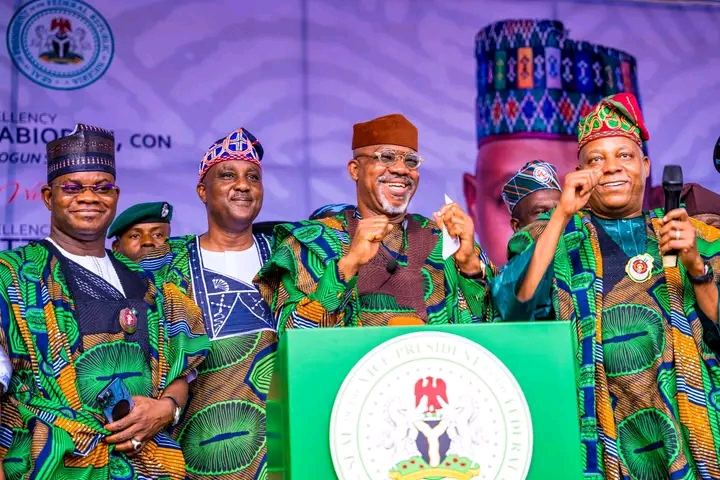Oba Jethro Adegoke Adejola was born on Thursday, February 20th, 1936 to the family of Oba Aderintola who happened to be the great grand father of Oba Jethro Adegoke Adejola’s father, by name Abraham Adejola.
Oba Jethro Adejola was not born in Osu but his grand father was born in Igila.
His grand father was ‘Omo Obara.’ According to history, it was in Igila that Owa Obara, Prince Jethro’s grand father was taken to become Owa of Ilesa.
Oba Jethro’s father came to Osu through his maternal source. His father, Abraham Adejola was born in Osu at a time when Looyin was the head of Osu.
In the course of development, Osu indigenes requested for one of the Owa Adimula princes to become the Loja of Osu and the candidature of Oba Jethro’s father, Abraham Adejola Oje Aderintola was approved ‘as the first Loja of Osu.’ The second Loja was Prince Adekanye and Prince Omolade Adeyokunnu was the third Loja.
Oba Adejola who is happily married with children went to Divisional Teacher Training College for his Grade 3 certificate course. After two years of teaching experience, he went back to Government Teacher Training College, Ibadan for his Grade 2 certificate.
Oba Adejola attended University of Ibadan between 1968 and 1970 and was later posted to Oyo as a teacher at Anglican Methodist Secondary Modern School before he was transferred to Abeokuta as a teacher at Elere Adubi Comprehensive School.
Oba Adejola last teaching station was Fakunle Comprehensive High school, Osogbo where he finally retired on November 11th, 1989 when he was installed as the Loja of Osun.
Osu indigenes thereafter wanted the title to be changed so as to fall in tune with what operates in other towns in Yorubaland.
Oba Jethro Adejola’s candidature and a native of Osu was approved as the fourth Loja of Osu.
According to tradition, certain traditional procedures peculiar to Ijesaland were followed on the issue of beaded crown for the Oba of Osu bearing in mind that ‘nobody has ever been the head of Osu community without being a prince of Owa Obokun of Ijesaland, a prince who has every claim to become the Owa of Ijesaland any time God will.
The status of Osu as the headquarters of the Atakumosa Local Government was another positive advantage in promoting Loja of Osu to the status of an Oba with the right to wear a beaded crown.
Loja Jethro Adejola and also a pastor in the Redeemed Christian Church of God was finally crowned as Olosu of Osu by Owa Obokun of Ijesaland, Oba Adekunle Aromolaran in 2009 and the then Governor of Osun State, presented the staff of office to Oba Jethro Adejola Aderintola II, Olosu of Osu.
History
The history of Osu as a community ‘is a conglomerate of separately founded homesteads (Apoles) or camps by warriors and hunters mostly of Ijesa in origin.’ Dire Goke Arimoro, in one of his books,
Osu from the Cradle explained that many of these homesteads had been founded in the late 17th and 18th centuries. According to him, ‘the amalgamation of the homesteads which became the harbinger of Osu community of today only occurred in the middle of the 19th century.’
Osu of today as the products of about twenty traditional homesteads due to the scourge of war, especially the Yoruba civil wars of the 1820s to 1830s, intra and inter-communal clashes has metamorphosed into eleven quarters and numbers of streets. In order not to make the apoles (homesteads) in Osu easy preys for Ibadan military adventurers and further attacks on Ijesa settlements, ‘the Owa Obokun of Ijesaland between 1846 and 1858, Owa Ofokutu, ordered all dispersed Ijesa settlements to unite into fairly small settlements.’
It is important to note that, as a result of geographical expansion and civilisation within Osu community,’ some new quarters like Bolorunduro and Atakunmosa are beginning to emerge and develop.
The etymology of the word “Osu” resonates with a particular school of thought that ‘Osu’ as the name of the town and coined from the statement made by the Chief emissary (Agba Emese) of Owa Obokun of Ijesaland, when he was directed to conduct the official unification of all the ‘Apoles’ that formed Osu community.’ According to Arimoro, the following story was told to support this claim:
Oloomi Adimula wi ki mi wi han hin pe libeee no oun su ‘in in jo si o
Libi a wa a a gan an lo i ki mi su ‘in in jo si.
O wi ibe laa san in soo
Ibe laa san in somo
Ibe ni hin ti a maa gbeeru si
Lagbara Owa’bokun Ijesa.
The word ‘Osu’ was coined from the above phrases in line 1 and 2. That is, Owa ‘Su’ in in jo (Unite you). Owa, the king of Ijesaland as God’s voice of unity and authority unite O-su = Osu. Beyond the difference between “Apole Osu” believed to have been founded by Pa Ariyo Ajibode and “Ilu Osu,” a confederate of separate autonomous homesteads, the origin and development of Osu monarch from looyin to an institutional monarch remains a source of inspiration and unity of purpose for Osu development. In the beginning the confederate homesteads (Apole) had its political and cultural head called ‘Looyin.’ The advent of civilisation brought to focus the need for a recognised central head.
As stated above ‘The Lojaship” title was later agreed upon with the installation of an Osu Prince, Pa Oje Orisakoomilade Aderintola as the first Loja of Osu community in 1934.
A Loja is a monarchical nomenclature given to an Owa Obokun Royal Prince who is made a head of a smaller Ijesa community by the Owa Obokun Adimula throughout Ijesa land. Loja Aderintola reigned for four years before he joined his ancestors in 1937.
He was succeeded by a non- indigene of Osu, but a prince of Owa, Loja Adekanye in 1938 and reigned for thirty four years before he joined his ancestors in 1972.
Loja Adekanye was succeded by Loja Omolade Adeyokunnu. He was not an indigene of Osu, but a prince of Owa Obokun. Loja Omolade Adeyokunnu’s reign ‘witnessed a dramatic development in the socio-political and economic life of the community.’ It is on record that ‘many of the intractable problems that had hitherto been the hall-mark of the community’s life were resolved during his tenure.
An acceptable Loja’s court was completed during his reign. The issue of Oke-Omi/Oke-Osu was eradicated and for once the recognition of Osu as a monolithic cultural group became a reality.’ It was during Loja Adeyokunnu’s reign that ‘Osu became the Headquarters of Atakumosa Local Government Area, Electricity was extended to Osu.
The second Grammar School, Osu Community Grammar School was founded and the issue of a central market for Osu was considerably resolved.’
Following his transition on 11th June, 1989, all Osu indigenes resolved to filled the vacant stool with an indigene and PRINCE Jethro Adegoke Adejola was approved and installed as the fourth Loja of Osu on 11th November, 1989 by the Owa Obokun Adimula of Ijesaland, Owa Aromolaran II and was upgraded from Lojaship to Olosu of Osu, Aderintola II in 2009 by Owa Aromolaran II to an institutional monarch with beaded crown.
Credit: Deji Okegbile





